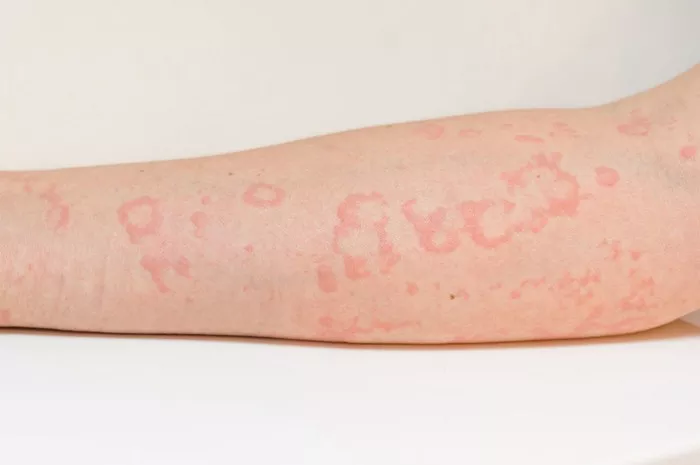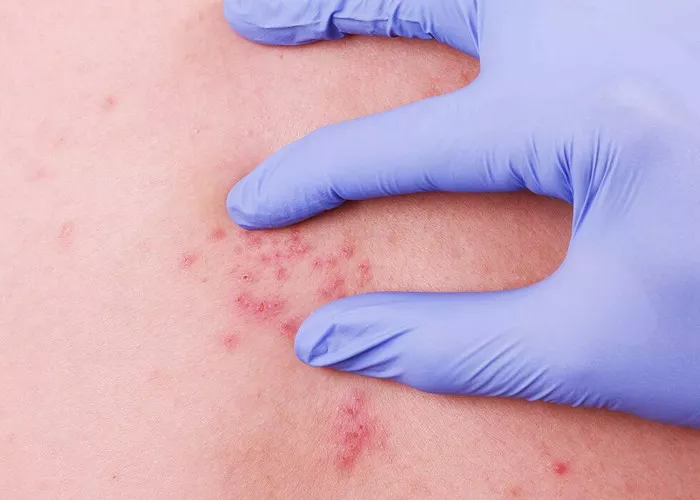Hives, or urticaria, are a common skin condition characterized by red, itchy welts that can appear anywhere on the body. While they can be particularly distressing and uncomfortable when they occur under the arms, understanding their causes is essential for effective treatment and prevention. This article delves into the various factors that contribute to the development of hives in this sensitive area, exploring everything from allergic reactions to underlying health conditions.
Understanding Hives: An Overview
Hives are raised, red, and often itchy welts on the skin. They can vary in size and shape and often move around the body, appearing in one area and then fading away, only to appear in another. Hives can last for a few hours to several weeks and are classified as either acute or chronic based on their duration. Acute hives last less than six weeks, while chronic hives persist beyond this period.
The Anatomy of the Underarm Area
The underarm area, or axilla, is a complex region with a unique combination of skin folds, hair follicles, sweat glands, and lymph nodes. The skin here is sensitive and often subject to friction, moisture, and irritation from various sources. This makes the underarms particularly susceptible to skin conditions, including hives.
Common Causes of Hives Under the Arms
1. Allergic Reactions
One of the most common causes of hives under the arms is an allergic reaction. This can be triggered by a wide range of allergens, including:
a. Personal Care Products
Deodorants, antiperspirants, soaps, and shaving creams often contain fragrances, preservatives, and other chemicals that can irritate the skin and cause allergic reactions. Even hypoallergenic products can sometimes provoke a reaction in sensitive individuals.
b. Laundry Detergents
Residues from laundry detergents and fabric softeners on clothing can come into contact with the underarm area, leading to hives. People with sensitive skin should opt for fragrance-free and dye-free laundry products.
c. Foods and Medications
Allergic reactions to certain foods and medications can manifest as hives, including under the arms. Common culprits include shellfish, nuts, eggs, antibiotics, and non-steroidal anti-inflammatory drugs (NSAIDs).
2. Physical Triggers
Physical triggers can also cause hives under the arms. These triggers include:
a. Heat and Sweat
The underarm area is prone to excessive sweating, especially in hot and humid conditions. Heat and sweat can irritate the skin and lead to the formation of hives. This condition, known as cholinergic urticaria, is more common in people who sweat excessively.
b. Friction
The constant friction between the skin and clothing or the rubbing of the skin folds in the underarm area can cause irritation and hives. Tight clothing and vigorous physical activity can exacerbate this issue.
3. Infections
Certain infections can cause hives under the arms. These include:
a. Bacterial Infections
Infections caused by bacteria such as Staphylococcus aureus can lead to skin irritation and hives. Folliculitis, an infection of the hair follicles, is a common bacterial infection that affects the underarm area.
b. Viral Infections
Viral infections, such as the common cold or flu, can trigger hives in some individuals. The body’s immune response to the virus can cause hives to develop in various areas, including under the arms.
4. Autoimmune Disorders
Autoimmune disorders occur when the body’s immune system mistakenly attacks its own tissues. Some autoimmune disorders can cause chronic hives, including under the arms. These disorders include:
a. Chronic Urticaria
Chronic urticaria is a condition characterized by the persistent presence of hives for more than six weeks. It is often linked to autoimmune processes, where the immune system targets the skin.
b. Lupus
Lupus is an autoimmune disorder that can cause a wide range of symptoms, including hives. The condition often leads to inflammation and skin issues, including hives under the arms.
5. Hormonal Changes
Hormonal fluctuations can affect the skin and immune system, leading to the development of hives. Common hormonal triggers include:
a. Menstrual Cycle
Some women experience hives as a result of hormonal changes during their menstrual cycle. These hives can appear in various areas, including under the arms.
b. Pregnancy
Pregnancy causes significant hormonal changes that can lead to skin conditions, including hives. Pregnant women may develop hives due to increased hormone levels and changes in the immune system.
Diagnosing Hives Under the Arms
Diagnosing the cause of hives under the arms involves a thorough evaluation by a healthcare provider. The process typically includes:
SEE ALSO: Does Lack of Sleep Cause Hives?
1. Medical History
A detailed medical history can help identify potential triggers and underlying conditions. This includes information about recent exposures to allergens, new personal care products, medications, and any known medical conditions.
2. Physical Examination
A physical examination of the affected area can provide clues about the cause of the hives. The healthcare provider will look for signs of infection, irritation, and other skin conditions.
3. Allergy Testing
Allergy testing can help identify specific allergens that may be causing the hives. This can include skin prick tests, patch tests, and blood tests to detect antibodies to common allergens.
4. Blood Tests
Blood tests can help diagnose underlying conditions that may be causing the hives. These tests can check for signs of infection, autoimmune disorders, and other health issues.
5. Biopsy
In rare cases, a skin biopsy may be performed to rule out other skin conditions and confirm the diagnosis of hives.
Treatment and Management of Hives Under the Arms
Treatment for hives under the arms focuses on relieving symptoms and addressing the underlying cause. This can include:
1. Avoiding Triggers
Identifying and avoiding triggers is crucial for preventing hives. This may involve changing personal care products, using hypoallergenic laundry detergents, and avoiding certain foods or medications.
2. Medications
Several medications can help manage the symptoms of hives, including:
a. Antihistamines
Antihistamines are commonly used to relieve itching and reduce the severity of hives. Over-the-counter options include cetirizine, loratadine, and diphenhydramine. Prescription antihistamines may be necessary for chronic or severe cases.
b. Corticosteroids
Topical corticosteroids can help reduce inflammation and relieve itching. Oral corticosteroids may be prescribed for severe or persistent hives.
c. Immunosuppressants
In cases of chronic urticaria or autoimmune-related hives, immunosuppressant medications may be necessary to control the immune system’s response.
3. Skincare
Proper skincare is essential for managing hives under the arms. This includes:
a. Gentle Cleansing
Using mild, fragrance-free soaps and cleansers can help prevent irritation. Avoiding hot water and scrubbing the skin can also reduce the risk of hives.
b. Moisturizing
Applying a gentle, fragrance-free moisturizer can help keep the skin hydrated and reduce irritation. This is especially important in areas prone to friction and dryness.
c. Avoiding Tight Clothing
Wearing loose-fitting clothing made of breathable fabrics can help reduce friction and moisture buildup, preventing hives under the arms.
4. Home Remedies
Several home remedies can help soothe hives and reduce symptoms, including:
a. Cool Compresses
Applying a cool compress to the affected area can help relieve itching and reduce swelling. This can be done several times a day as needed.
b. Oatmeal Baths
Taking an oatmeal bath can help soothe irritated skin and reduce itching. Colloidal oatmeal, available at most drugstores, can be added to bathwater for a soothing soak.
c. Aloe Vera
Aloe vera has anti-inflammatory and soothing properties that can help relieve the symptoms of hives. Applying pure aloe vera gel to the affected area can provide relief.
Preventing Hives Under the Arms
Preventing hives under the arms involves taking steps to reduce exposure to potential triggers and maintaining healthy skin. This can include:
1. Identifying Allergens
Working with a healthcare provider to identify specific allergens can help prevent hives. Allergy testing can be useful in pinpointing triggers.
2. Maintaining Good Hygiene
Keeping the underarm area clean and dry can help prevent infections and irritation. Regular bathing and the use of antiperspirants can help control sweat and moisture.
3. Using Hypoallergenic Products
Choosing hypoallergenic and fragrance-free personal care products can reduce the risk of allergic reactions. This includes deodorants, soaps, and laundry detergents.
4. Managing Stress
Stress can exacerbate skin conditions, including hives. Practicing stress-reducing techniques such as yoga, meditation, and deep breathing can help prevent flare-ups.
5. Seeking Medical Advice
Regular check-ups with a healthcare provider can help manage underlying conditions that may contribute to hives. This includes managing autoimmune disorders and other chronic health issues.
Conclusion
Hives under the arms can be uncomfortable and distressing, but understanding their causes and taking proactive steps can help manage and prevent them. Allergic reactions, physical triggers, infections, autoimmune disorders, and hormonal changes are common contributors to this condition. By identifying and avoiding triggers, using appropriate medications, and maintaining healthy skincare practices, individuals can effectively manage hives and reduce their impact on daily life. Regular consultation with healthcare providers is essential for proper diagnosis and treatment, ensuring that any underlying health issues are addressed.
Related Topics:


























